IT Service Desk Management
Providing a coordinated, effective, and positive client service experience is a complex proposition for many IT organizations. Service requests can originate from multiple sources—such as in person, by phone call, e-mail, social media, and chat. Clients may be in trying situations that require rapid response and problem resolution. At the same time, budget issues may impact the availability of help desk resources. IT service desk management systems help overcome these challenges. They optimize the client experience: Self-service tools help clients resolve problems or initiate service requests themselves; sophisticated ticketing systems manage and track service requests efficiently; feedback, analytics, and reporting tools help IT organizations refine service processes and staffing, diagnose IT service and system outages quickly, and identify broader improvements to IT operations and infrastructure.
The Market
The IT service desk management system market was the third fastest-changing system area in 2016, moving up one slot from 2015 (figure 2). Contributing to this change, market share for ServiceNow increased from 6% in 2011 to 14% in 2016; institutions are also moving away from homegrown solutions (11% in 2011 versus 5% in 2016; figure 3). With just over half of institutions using one of the top 5 vendors (BMC Software, 20%; ServiceNow, 14%; SolarWinds, 8%; TeamDynamix, 5%; Dell KACE, 5%), there is a lot to choose from in this heterogeneous market (figure 4).



Case Study: Ticket-Tracking for Better Planning and Customer Service at Highline College
As of January 2016, the Information Technology Services (ITS) student/faculty/staff helpdesk operation at Highline College had long used a single help desk e-mail address and phone number to handle its 1,200 annual user requests, with some calls still going directly to individual ITS staff. Staff couldn't easily track and manage each problem's resolution, nor could they gather performance metrics. Additionally, Highline's highly diverse student population—with almost 17,000 students from more than 120 cultures and ethnicities—meant that ITS had the added dimension of assisting people from a wide range of backgrounds. ITS recognized the need to improve its help desk operations.
When Theresa Duhart, ITS customer services manager, came on board in January 2016, one of her first tasks was to purchase an IT service desk management system. "E-mail requests were difficult to track," she explained. "We didn't know what kind of job we were doing—whether we provide appropriate assistance in a timely manner or if we miss the mark." ITS embarked on a system selection process. First, they developed a feature checklist based on ITS and user needs, including:
- Easy request tracking
- Web-based solution with the ability to create tickets from incoming e-mail and to send e-mail
- User-friendly interface for service requesters and ITS—e.g., intuitive information input prompts
- Customizable tickets to collect relevant service requester and problem information
- Automatic ticket queuing, routing, and as-needed escalation of predefined problems
- Authentication to ensure the correct requester information within the ticket
- Reporting capability to analyze system metrics
- Knowledgebase of frequently asked questions (FAQs), articles, and other resources to help users resolve technology problems on their own
- Easy-to-generate customer satisfaction surveys, launched after close of ticket and/or upon demand
- Easy implementation and staff training
- Scalable to future requirements—e.g., adoption of Information Technology Infrastructure Library (ITIL) service management practices
Next came a system-needs evaluation, which included contemplation of an open-source versus a vendor solution and of an on-premise versus a cloud-based solution. Budget and time were key factors. "Many institutions choose an open-source IT service desk management solution because it's freely available; they don't have the funds to purchase a vendor solution," stated Duhart. "But I needed to be conscious of the staff time and resources to manage an open-source solution."
The final step entailed a feature/solution matchup. In April 2016, SolarWinds, a web-based solution hosted on a local server, emerged as the solution of choice due to its features, cost effectiveness, and ability to meet ITS and campus community needs. ITS deployed it by June, and today, Highline's new IT service desk management system provides a one-stop source for campus users to submit support request tickets via e-mail or online, from a desktop or mobile device. Users can manage their service requests by checking for status and updated information and viewing past tickets. The system automatically routes the request to the appropriate ITS staff or group, notifies the user when the ticket is updated and/or resolved, and provides an opportunity for users to give feedback on their support experience. A knowledgebase of user resources is still under construction.
Moving to the new system presented one challenge—training users on how to fill out the help request ticket correctly. Before, users reported their problems in an unstructured e-mail or phone call; now they had to enter specific details into a fixed help request form—hence, a reason for choosing a very user-friendly system. To help users transition, ITS created online tutorials and quick guides about ticket creation and system expectations, which they shared via a campus-wide e-mail three days before the new system's deployment. They also linked these resources to the system's login page. In addition, Duhart and Tim Wrye, executive director of ITS and CIO, discussed and introduced the system at various technology group meetings around campus.
The new system went live the Monday after the 2016 spring quarter ended to minimize disruption. The old help request e-mail address remained live eight days after deployment to smooth the transition, but then ITS turned it off to redirect users to the new system. Students and staff adopted the new system easily, but a hiccup occurred with some faculty members. The rollout occurred just as many left for the summer, and some faculty needed to relearn the new help request procedures upon their return in the fall.
Duhart outlined these lessons learned during Highline's IT service desk management system selection and implementation:
- Develop a detailed shopping list: Duhart felt the IT service desk management system market offered many different solution possibilities. She developed a checklist of desired features to identify possible solutions more easily. She emphasized a forward-looking orientation in her list, too. For example, ITS hasn't adopted ITIL practices yet but would like to move in that direction in the future. "So it was important to have an ITIL-compliant product," explained Duhart. "Even though we were not there now, we could be there in a couple of years."
- Your IT department is your customer, too: Keep in mind the IT service desk management system's importance both as an internal management as well as an external customer service tool. "The entire department has to be on board with the new system because everyone has to use it," explained Duhart. "You don't want them to be hands-off." She facilitated buy-in by including the entire ITS department in the project. For example, ITS as well as user needs impacted system selection. Staff from various ITS areas helped customize system and service request tickets to ensure the collection of all required information. ITS department members trained and internalized the new system features and processes into their work practices.
- Minimize disruption: Users rely on the help desk to solve their technology issues, and it is logical not to change help request procedures and systems during particularly busy or stressful times—e.g., the beginning or end of a quarter. ITS determined the end of the spring quarter to be best system deployment time frame after consulting the academic calendar and meeting with functional-department heads about their workloads. But ITS discovered that disruption minimization required longer-term planning when faculty members required refresher training upon their return to campus from their summer activities.
Today, Duhart and her team enjoy numerous benefits from their IT service desk management system. They can track all of the system-generated service requests, which helps tremendously in problem routing to appropriate staff, identification of system-wide outages, staff deployment during peak day and quarter periods, and user-satisfaction tracking.